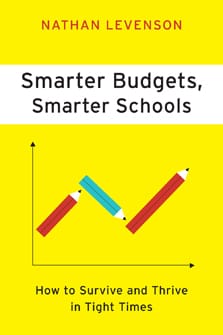 For school administrators and board members lost in the forest of books, reports, and briefs written on “doing more with less,” this outstanding volume provides a compass, map, and sturdy walking stick. Finance guru (and former superintendent of Arlington [MA] Public Schools) Nathan Levenson offers rational, honest, and tangible ways for cash-strapped district leaders to shed budget heft without compromising student learning. Guided by four principles—embrace “crazy” ideas, analyze details to make informed decisions, spend on what works, and align interests—Levenson explains how to manage even the most sacrosanct of education-budget items (all without the need for legislative changes or union approval). For example, district leaders should base funding on academic return on investment (A-ROI) determinations—cutting ineffective programs and beefing up those that see results. Take early investment in reading: In an average-sized elementary school (about 400 students), early reading intervention costs about $2,500 per child (and takes about three years to get struggling students up to grade level). Compare this with special-education referral and placement—which costs an additional $5,000 per year (for mild to moderately disabled students) and likely will last throughout the student’s K-12 career. This need to look beyond singular budget line-items manifests in staffing costs as well. Superintendents must think about fully loaded costs (salary plus benefits) when planning for personnel shifts—and must be willing to think creatively about how to fill certain positions. Levenson provides an anecdote: To save the district long-term dollars, he reclassified a part-time clerical office position as “paraprofessional” (meaning that it didn’t qualify for benefits packages or fit union rules for automatic salary step increases). The first fully loaded cost totaled about $80,000 for the position instead of $350,000 in the old system. Along with these insightful and concrete examples, Levenson provides sample budgets, staffing formulae, and worksheets—all geared toward helping readers find specific solutions to their individual districts’ budget woes. (The book also has a linked online tool that further simplifies this process for district admins.) It blazes a clear trail to leaner and more productive district spending—prepare to take notes.
For school administrators and board members lost in the forest of books, reports, and briefs written on “doing more with less,” this outstanding volume provides a compass, map, and sturdy walking stick. Finance guru (and former superintendent of Arlington [MA] Public Schools) Nathan Levenson offers rational, honest, and tangible ways for cash-strapped district leaders to shed budget heft without compromising student learning. Guided by four principles—embrace “crazy” ideas, analyze details to make informed decisions, spend on what works, and align interests—Levenson explains how to manage even the most sacrosanct of education-budget items (all without the need for legislative changes or union approval). For example, district leaders should base funding on academic return on investment (A-ROI) determinations—cutting ineffective programs and beefing up those that see results. Take early investment in reading: In an average-sized elementary school (about 400 students), early reading intervention costs about $2,500 per child (and takes about three years to get struggling students up to grade level). Compare this with special-education referral and placement—which costs an additional $5,000 per year (for mild to moderately disabled students) and likely will last throughout the student’s K-12 career. This need to look beyond singular budget line-items manifests in staffing costs as well. Superintendents must think about fully loaded costs (salary plus benefits) when planning for personnel shifts—and must be willing to think creatively about how to fill certain positions. Levenson provides an anecdote: To save the district long-term dollars, he reclassified a part-time clerical office position as “paraprofessional” (meaning that it didn’t qualify for benefits packages or fit union rules for automatic salary step increases). The first fully loaded cost totaled about $80,000 for the position instead of $350,000 in the old system. Along with these insightful and concrete examples, Levenson provides sample budgets, staffing formulae, and worksheets—all geared toward helping readers find specific solutions to their individual districts’ budget woes. (The book also has a linked online tool that further simplifies this process for district admins.) It blazes a clear trail to leaner and more productive district spending—prepare to take notes.
Nathan Levenson, Smarter Budgets, Smarter Schools: How to Survive and Thrive in Tight Times (Cambridge, MA: Harvard Education Press, 2012).
